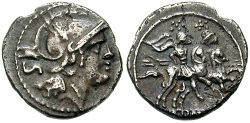
Back سيسترتيوس Arabic Сестэрцый Byelorussian Сэстэрцый BE-X-OLD Сестерция Bulgarian Sesters Breton Sesterci Catalan Сестерци CE Sestercius Czech Sesterz German Σηστέρτιος Greek
This article needs additional citations for verification. (October 2007) |
| Anonymous AR sestertius | |
|---|---|

| |
| Helmed Roma head right, IIS behind | Dioscuri riding right, ROMA in linear frame below. RSC4, C44/7, BMC13 |
| AR 0.96 g – RSC4, C44/7, BMC13 | |
The sestertius (pl.: sestertii) or sesterce (pl.: sesterces) was an ancient Roman coin. During the Roman Republic it was a small, silver coin issued only on rare occasions. During the Roman Empire it was a large brass coin.
The name sestertius means "two and one half", referring to its nominal value of two and a half asses (a bronze Roman coin, singular as), a value that was useful for commerce because it was one quarter of a denarius, a coin worth ten asses. The name is derived from semis, "half" and tertius, "third", in which "third" refers to the third as: the sestertius was worth two full asses and half of a third.
English-language sources routinely use the original Latin form sestertius, plural sestertii; but older literature frequently uses sesterce, plural sesterces, terce being the English equivalent of tertius. A modern shorthand for values in sestertii is IIS (Unicode 𐆘), in which the Roman numeral II is followed by S for semis, and the whole struck through; but because this symbol and striking through letters are not always convenient, HS may be used instead, with the horizontal bar of the 'H' representing the strike through the numeral II, rather than the letter H.[1]

- ^ Kennedy, Benjamin Hall (1930). The Revised Latin Primer. London: Longmans. p. 214.